|
 Secure Site
Secure Site
|
 |
Archive for the 'Goodness' Category
 how to cultivate compassion Cultivate equanimity in the face of life’s ups and downs, and find deeper access to joy.
A lot of people I know avoid reading the paper first thing in the morning—being confronted with all of the injustices and bad deeds in the world is an unsettling way to start the day. It’s difficult to read about the latest corporate finance scam or the obscenity of human trafficking and keep your peace of mind, and it’s even harder to know how to respond. The conflict feels even more immediate when you witness an unjust act firsthand, or are yourself the recipient of one, whether it’s having your wallet stolen, your car broken into, or any sort of hurtful behavior directed your way. The answer to this problem could be upeksha, the fourth of the brahmaviharas.
This understanding of upeksha as equanimity stresses the importance of balance. A balanced heart is not an unfeeling heart. The balanced heart feels pleasure without grasping and clinging at it, it feels pain without condemning or hating, and it stays open to neutral experiences with presence. Insight meditation teacher Sharon Salzberg speaks of equanimity as a “spacious stillness of mind,” within which we can remain connected to others and all that happens around us, while remaining free of our conditioned habit of grasping at the pleasant and pushing away the unpleasant.
Calm Within
One way to experience equanimity is to experiment with mindfulness meditation. Rather than fixing attention on a single object such as the breath or a mantra, mindfulness meditation involves the moment-to-moment awareness of changing objects of perception. Mindfulness is like a floodlight, shining awareness on the whole field of experience, including sensations, emotions, and thoughts as they arise and pass away in the dynamic, ever-changing flux that characterizes the human experience of body and mind. Mindfulness allows you to see the nature of the unfolding process without getting caught in reactivity, without identifying with your sensations, emotions, and thoughts. This insight changes your relationship to the mind-body. The waves keep coming, but you don’t get swept away by them. Or as Swami Satchidananda often said, “You can’t stop the waves, but you can learn to surf!” This ability to remain balanced amidst ever-changing conditions is the balance of equanimity.
 How to be calm within There’s an old story that illustrates the wisdom of this state of mind. A farmer’s most valuable asset is the one horse he owns. One day it runs away. All the townspeople commiserate with him, “Oh, what terrible luck! You’ve fallen into poverty now, with no way to pull the plow or move your goods!” The farmer merely responds, “I don’t know if it’s unfortunate or not; all I know is that my horse is gone.”
A few days later, the horse returns, and following it are six more horses, both stallions and mares. The townspeople say “Oh! You’ve struck it rich! Now you have seven horses to your name!” Again, the farmer says, “I don’t know if I’m fortunate or not; all that I can say is that I now have seven horses in my stable.”
A few days later, while the farmer’s son is trying to break in one of the wild stallions, he’s thrown from the horse and breaks his leg and shoulder. All the townspeople bemoan his fate: “Oh, how terrible! Your son has been so badly injured, he’ll not be able to help you with the harvest. What a misfortune!” The farmer responds, “I don’t know if it’s a misfortune or not; what I know is that my son has been injured.”
Less than a week later, the army sweeps through town, conscripting all the young men to fight in a war…all except for the farmer’s son, who is unable to fight because of his injury.
The fact is, you can’t know what changes your life will bring or what the ultimate consequences will be. Equanimity allows for the mystery of things: the unknowable, uncontrollable nature of things to
be just as they are. In this radical acceptance lies peace and freedom—right there in the midst of whatever pleasant or unpleasant circumstances we find ourselves in. When we open to the truth that there is actually very little we can control other than our own reactions to circumstances, we learn to let go. Cultivating the qualities of kindness, compassion, and joy opens your heart to others. Equanimity balances the giving of your heart’s love with the recognition and acceptance that things are the way they are. However much you may care for someone, however much you may do for others, however much you would like to control things or you wish that they were other than they are, equanimity reminds you that all beings everywhere are responsible for their own actions, and for the consequences of their actions.
Without this recognition, it’s easy to fall into compassion fatigue, helper-burnout, and even despair. Equanimity allows you to open your heart and offer love, kindness, compassion, and rejoicing, while letting go of your expectations and attachment to results. Equanimity endows the other three brahmaviharas with kshanti: patience, persistence, and forbearance. So, you can keep your heart open, even if the kindness, compassion and appreciative joy you offer to others is not returned. And when you are confronted with the nonvirtuous deeds of others, equanimity allows you to feel compassion for the suffering that underlies their actions as well as for the suffering their actions cause others. It is equanimity that brings immeasurability or boundlessness to the other three brahmaviharas.
adapted from Yoga Journal Magazine, by By Frank Jude Boccio
Frank Jude Boccio is a teacher of yoga and Zen Buddhism and the author of Mindfulness Yoga. Find him at mindfulnessyoga.net
Use our unique “Zen Clock” which functions as a Yoga & Meditation Timer. It features a long-resonating acoustic chime that brings your meditation or yoga session to a gradual close, preserving the environment of stillness while also acting as an effective time signal. Our Yoga Timer & Clock can be programmed to chime at the end of the meditation or yoga session or periodically throughout the session as a kind of sonic yantra. The beauty and functionality of the Zen Clock/Timer makes it a meditation tool that can actually help you “make time” for meditation in your life. Bring yourself back to balance.
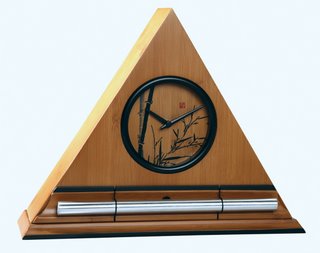 Zen Clock with Gentle Chime to Awaken You Gradually Now & Zen’s Clock and Meditation Timer Store
1638 Pearl Street
Boulder, CO 80302
(800) 779-6383
Posted in Goodness, intention, Meditation Timers, Meditation Tools, mindfulness practice, prayer, Well-being, Zen Timers
 Kiyonaga Torii, Beauties Listening to Bonsai Vendor Ukiyo-e Woodblock Print How can we save the world from growing intolerance, how can we stop the spiral of violence? ‘ Silence is often the best answer,’ says the Dalai Lama. More and more experts are admitting he is right. This is not the time for analyses, reports and threats. We now need to stop and take the time to really listen to one another. Of course, listening is not always easy, but a growing number of initiatives are aiming to help people master this difficult art. The International Listening Association declared March to be International Awareness Month.
As part of their campaign they gave tips on how to listen. ‘Count to three when the person you are speaking with has finished talking. That person will often take this to be a signal to go on talking. You will be surprised at how much extra information you get. If you are interrupted, do not get irritated, do not attack and do not lecture, but simply say: “Please listen for a moment, I am not finished yet.”
The American psychologist Michael Kahn wrote a book that includes the topic of listening: The Tao of Conversation (Rainbow Pockets, 1998). He describes people entering a conversation with the intention of winning, people that only feel better if the other person feels worse. ‘We so badly want to be heard and confirmed that we think it is worth having an argument. ‘ The listener is the one who is catching his breath after having presented his view.
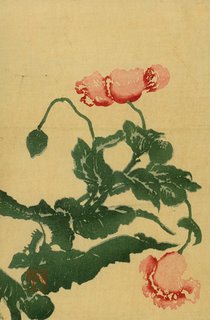 Peonies, c. 1900 unknown Kahn explains what a relief it was when he discovered a conversation does not have to be a contest. Like the Tao, it can flow calmly and peacefully and still be very powerful. Kahn’s tip: ‘Engage in a conversation as if you were making love to someone. Your good mood depends on how good the other feels. Or is your idea of a conversation a jam session, where musicians listen to each other and are inspired by each other? Ask yourself: Do I want to learn or do I want to win?’
Listening, true listening, heals. This was beautifully described years ago in Michael Ende’s classic Momo and the time savers. Because she is the only one in a hurried world who has time to really listen, the little vagabond girl Momo steals the hearts of all. Even children – taking after their parents – have less and less time for stories and games. In the end, Momo saves the city from the gloomy oppression of the grey men who are stealing everybody’s time. Listening as the solution to the world’s problems seems so simple, but in practice turns out to an enormous challenge. It is time we learned that history only repeats itself because nobody was listening the first time.
One of the ultimate Zen like experiences is waking-up from a great slumber refreshed and energized. Your mind and body are harmoniously one, both alert and focused. Having a refreshed mind and body are two keys to a natural and Zen lifestyle. Waking up in the morning should not be a loud and abrupt awakening, but rather it should be a peaceful positive experience. The right natural alarm clock can transition your deep and tranquil sleep into a serene start to consciousness. Imagine a long-resonating Tibetan bell-like chime waking you up to a beautiful morning experience.
The right alarm clock can be the most beneficial investment for you. With our Now & Zen natural alarm clock you are awakened more gradually and thus more naturally. Now & Zen is focused on creating a naturalistic lifestyle, and our clocks are an example of our philosophy.
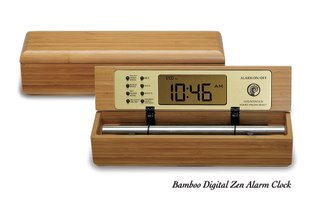 Bamboo Digital Chime Clock, a calming timer and alarm clock made from natural materials like bamboo, walnut, and maple adapted from Ode Magazine, April 2003 by Tijn Touber
Now & Zen’s Soothing Alarm Clock Store
1638 Pearl Street
Boulder, CO 80302
(800) 779-6383
Posted in Bamboo Chime Clocks, Chime Alarm Clocks, Goodness, Japanese Inspired Zen Clocks, Meditation Timers, Meditation Tools, mindfulness practice, Natural Awakening, Progressive Awakening, Truth, Well-being
 Warm winter sun “Imagine yourself outside on a beautiful Saturday afternoon, just in the flow, enjoying life. Suddenly the sun disappears behind a cloud that you didn’t know was there. It’s dark now, and you feel off kilter, sad.”
That’s how LeNeva Spires, who works as an executive assistant at a university in Portland, Oregon, describes the seasonal affective disorder (SAD) that affects her every autumn.
Though classified as a type of depression, “it feels more like something is missing, like things are not quite right,” says Spires.
It’s precisely brightness (or rather, the lack of it) that triggers this mood disorder, one of few health problems tied to a season. SAD primarily affects people who live in northern latitudes (above San Francisco and Washington, D.C.), and more women than men. It often begins in September or October, as the days shorten, and lingers until spring.
SAD tends to respond readily to the very thing we’re missing in the winter months: light. Learn how to get more of it as well as discover the best foods, exercise, supplements, and herbs to create your action plan for a brighter, happier winter.
1. Let There Be Light
For seasonal depression and the winter blahs, “the treatment of choice is light,” says psychiatrist Alfred Lewy. How do you get that light? You could move closer to the equator, where the sun rises and sets at a more consistent time all year long. Or, if your family and work life allow it, you could change your sleep schedule during the winter so you wake up a half-hour after sunrise (check your local paper to find out when the sun rises), and then go immediately outside.
But for most of us, the easiest option is to purchase a light box outfitted with special bulbs that mimic the brightness of the morning sun. Light therapy works by getting our sleep-wake cycle to synchronize with an electric-powered “sun,” thereby resetting our circadian clock. We tend to feel our best when we wake with the dawn, and the light box essentially helps you make your own dawn.
Light-Box Lowdown
Available online and at specialty stores (starting at about $160), light boxes are safe to use at home, whether or not you have an official diagnosis of SAD. Lewy recommends placing the light box at a 45-degree angle to you, from either the side or above, and starting with a morning dose of light: about 30 minutes, taken between 6 a.m. and 8 a.m. Some people may need more time — 45 minutes, or even up to two hours — but once they feel an improvement in their mood, they can reduce the sessions to 30 minutes.
The light receptors that help rest our circadian clocks reside in our eyes, so keep your eyes open during light treatment. In fact, Lewy suggests glancing sideways at the lightbulbs once or twice every minute (something you should never do with the real sun).
A small number of SAD sufferers respond best to early-evening light treatments. After a week or two of morning treatment, if you notice no improvement even with two-hour doses, try the evening sessions instead, suggests Lewy. People usually begin to feel better within a few days but should keep up the treatments daily, ideally from the onset of symptoms (usually in September or October) through at least March.
 bring on the night 2. Bring On the Night
You need a good night’s sleep in order to mitigate winter depression — and by “good,” Emmons means sleeping for eight or nine hours a night — but not more. Keep bedtime and wake-up time consistent, too; Emmons suggests going to bed between 10 and 11 p.m. and rising between 6 and 7 a.m.
Melatonin Matters
While light-box therapy remains the primary remedy for synchronizing your sleep patterns, supplementing with melatonin (the “darkness” neurotransmitter) may help, too. The brain’s melatonin levels rise to their highest level at night, and people normally start secreting the hormone a few hours before bedtime, to prime the body for sleep.
Like light therapy in the morning, taking melatonin supplements in the afternoon can help shift the circadian clock. In fact, Lewy often prescribes both morning light and 0.3 mg to 0.5 mg of melatonin in the afternoon for best results in resyncing the circadian processes. Since melatonin can make some people sleepy, avoid driving as you figure out the best dosage. You’ll find melatonin tablets at natural-foods stores.
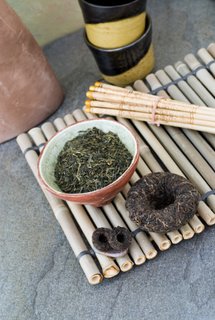 eat well 3. Eat to Feel Good
What we eat can affect our brain chemistry and our mood. To combat SAD, Emmons recommends focusing on foods that increase and stabilize levels of serotonin, a mood-improving hormone that tends to decrease in the winter. These foods include choices rich in tryptophan, a building block of serotonin.
We often crave high-carbohydrate comfort foods in winter, but it’s wise to resist the urge, he says. As he explains it, indulging in refined carbs, such as white bread and white rice, may indeed offer an initial feel-good spike in serotonin levels. But, as with a sugar rush, refined carbs end up depleting our serotonin levels soon after.
Instead, eat a variety of complex carbohydrates, such as barley, brown rice, oats, and other whole grains, and include a small amount of lean protein, ideally a high-tryptophan protein (turkey, cheese, eggs) at each meal or snack. Also include leafy green vegetables, such as kale and bok choy, which provide mood-supporting B vitamins and minerals that help convert tryptophan into serotonin.
4. Move and Stretch
“Exercise helps [all types of depression] for many reasons,” says Emmons. It boosts serotonin levels in the brain; it improves circulation, which gets more blood and nutrients to the brain; it increases energy and metabolism, even at the cellular level; and it improves glucose regulation, which also affects energy levels.
For those taking antidepressant medication, exercise helps improve the effectiveness of the drug, likely by improving circulation. More of the medicine gets to the brain, where it’s needed, and the body metabolizes the drug more easily, which reduces side effects.
The best news about SAD and exercise, says Emmons, is that you don’t have to take your workout to the extreme. Mild aerobic exercise for 30 minutes can usually lighten your mood. If it’s not too cold, walking outdoors is a great option. At the gym, try the stationary bike or treadmill for a half-hour every day.
5. Supplement Smartly
Several dietary supplements can help fill in any nutritional gaps and in turn may lift your mood. Emmons says his clients have had success with the following four:
Vitamin D
Deficiency in this vitamin is extremely common and may contribute to both ordinary and seasonal depression (along with other illnesses). While light boxes substitute for the sun in certain ways, they don’t provide this critical nutrient (which is more of a hormone than a vitamin). In the winter, a vitamin D supplement can help regulate your mood.
Dosage: 2,000 IU of vitamin D3 daily
Multivitamin
A good one includes plenty of B vitamins, as well as key minerals such as selenium (which helps support mood) and magnesium (which reduces anxiety and muscle tension).
Dosage: 1 daily
B-Vitamin Complex
These assist the brain in producing neurotransmitters such as serotonin and norepinephrine.
Dosage: One B-50 supplement daily (along with the multivitamin)
Omega-3-Rich Fish Oil
Studies suggest that omega-3 fatty acids may help prevent and ease depression and other mood disorders. Flax makes a good substitute for strict vegetarians.
Dosage: 1,000 mg of fish oil in capsule form twice daily, or 1 tablespoon of flax oil twice a day
6. Take It Outside
 go outside to cheer up Spending time outdoors helps us reconnect with nature, says Emmons, thus healing a rift that seems to lie at the heart of seasonal depression. If you combine a serotonin-boosting exercise with your outdoor time — like a brisk walk at a local park or an afternoon of cross-country skiing — you’re combating the winter blues on two fronts.
During the summer, take advantage of the sunlight by spending 15 to 20 minutes a day in the sun without sunscreen (unless you’re at risk of skin cancer). This will help build your vitamin D levels for next year.
7. Try Healing Herbs
Certain medicinal plants ease the winter blues, says Margi Flint, who runs the Earthson Herbals school in Marblehead, Massachusetts.
Uplifting Tea
For a mild, mood-boosting infusion, simmer 1 ounce oatstraw in 1 quart of water for 40 to 60 minutes. Remove from heat, add 2 tablespoons of dried chamomile and 2 tablespoons of dried lemon balm; cover and steep for 15 minutes. Strain and drink several cups daily.
Aromatherapy
Since the smell of any citrus uplifts the spirit, add a total of 10 drops of any combination of lemon, lime, and orange essential oils to each ounce of lotion or massage oil. Use daily, or use these oils in a diffuser.
Daily Tonic
Holy basil, ashwaganda, and gotu dola — from India’s traditional system of medicine, Ayurveda — help ease depression. Flint suggests using the powdered form; add a 1/4 teaspoon of each to oatmeal or applesauce.
8. Don’t Go It Alone
As with any form of depression, working with a mental-health professional for SAD can be beneficial. If you experience suicidal thoughts or other serious symptoms, seek help immediately.
One of the ultimate Zen like experiences is waking-up from a great slumber refreshed and energized. Your mind and body are harmoniously one, both alert and focused. Having a refreshed mind and body are two keys to a natural and Zen lifestyle. Waking up in the morning should not be a loud and abrupt awakening, but rather it should be a peaceful positive experience. The right natural alarm clock can transition your deep and tranquil sleep into a serene start to consciousness. Imagine a long-resonating Tibetan bell-like chime waking you up to a beautiful morning experience.
The right alarm clock can be the most beneficial investment for you. With our Now & Zen natural alarm clock you are awakened more gradually and thus more naturally. Now & Zen is focused on creating a naturalistic lifestyle, and our clocks are an example of our philosophy.
adapted from Body + Soul, January/February 2009
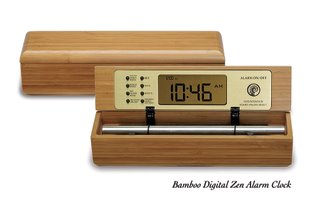 Bamboo Alarm Clocks & Meditation Timers
Now & Zen – Gradual Chime Alarm Clock Store
1638 Pearl Street
Boulder, CO 80302
(800) 779-6383
Posted in Goodness, Insomnia, intention, sleep, Sleep Habits, Well-being, Zen Timers
 soup This nourishing soup bolsters immunity and helps ease cold and flu symptoms, says herbalist Rosemary Gladstar. Fresh burdock root (also called gobo) and dandelion root are available in some grocery stores. Dried burdock, astragalus, and dandelion root are available at herb stores or online.
Ingredients
Makes about 3 quarts
- 1 ounce dried astragalus root
- 4 ounces fresh dandelion root, thinly sliced (or 2 ounces dried)
- 4 ounces fresh burdock root, thinly sliced (or 2 ounces dried)
- 1 tablespoon grated fresh gingerroot
- 1 tablespoon dried kelp, dulse, or other sea vegetable
- 2 tablespoons olive oil
- 1 medium-size onion, chopped
- 5 to 8 medium-size fresh shiitake mushrooms
- 2 to 3 cloves garlic, minced
- 1/2 cup miso paste, (any variety)
Directions
- Bring 3 quarts of water to a boil and reduce heat. Add astragalus, dandelion, burdock, ginger, and sea vegetable; set your Zen Alarm Clock and Timer for 45minutes to an hour and cover and simmer. Strain, return broth to pot, and keep over medium heat. In a saute pan, heat olive oil over medium heat; add onion and mushrooms, and saute until tender. Add garlic; saute for a few more minutes. Add entire mixture to broth. Turn off heat, and stir in miso paste.
 Bamboo Zen Timer adapted from Body + Soul, November/December 2006
“The Zen Alarm Clock & Chime Timer’, uses soothing acoustic chimes that signal it’s time – gently and gradually.
Rather than an artificial recorded sound played through a speaker, the Zen Clock features an alloy chime bar similar to a wind chime. When the clock’s alarm is triggered, its chime produces a long-resonating, beautiful acoustic tone reminiscent of a temple gong.
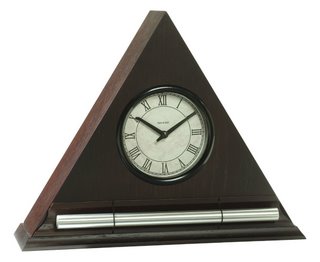 How to Use your Zen Alarm Clock and Timer to time Soup Now & Zen
– The Zen Timer Store
1638 Pearl Street
Boulder, CO 80302
(800) 779-6383
Posted in Bamboo Chime Clocks, Goodness
 Pierre-Cécile Puvis de Chavannes: The Dream, 1883
Sleep Type: The Human Alarm Clock
You crash as soon as your head hits the pillow, but wake like clockwork at 2, 3, or 4 a.m.
What’s Going On?
“We all wake up briefly — two to three dozen times a night — without awareness or memory,” says Paul Glovinsky, Ph.D., coauthor of “The Insomnia Answer.” If you’re all too aware of your awakenings, a number of things may be going on. Simple conditioning, a la Pavlov’s dogs, could be to blame. Your body can be “on the lookout for that awakening, especially if there’s a clock in the bedroom,” Glovinksy says. Also consider stress: You may fall asleep out of pure exhaustion, but as soon as your sleep needs are slightly quenched, anxieties wake you up again. For some people, says Rubin Naiman, Ph.D., director of Sleep Programs at Miraval Resort, the body’s inner clock, or circadian rhythms, may be malfunctioning
What to Do
Whatever’s behind your awakenings, hiding your neon time reminder is step one. This would be the perfect time to get the Zen Alarm Clock in the Digital style (so you could close the lid) or the original style without the light. If you can’t see the clock, you won’t panic as you calculate how many hours remain until daybreak — and how little you’ve slept. “Put it on the floor or close the cover to the Zen Clock,” says Joyce Walsleben, R.N., Ph.D., associate professor of medicine at New York University. “When the alarm chimes, you can get up, but otherwise, you’re in bed to sleep.” For many people, this simple shift alone reconditions their brain.
Boulder, Colorado—an innovative company has taken one of life’s most unpleasant experiences (being startled awake by your alarm clock early Monday morning), and transformed it into something to actually look forward to. “The Zen Alarm Clock,” uses soothing acoustic chimes that awaken users gently and gradually, making waking up a real pleasure.
What makes this gentle awakening experience so exquisite is the sound of the natural acoustic chime, which has been tuned to produce the same tones as the tuning forks used by musical therapists. According to the product’s inventor, Steve McIntosh, “once you experience this way of being gradually awakened with beautiful acoustic tones, no other alarm clock will ever do.”
adapted from Body + Soul, May 2008 by Sarah Schmelling
 Alarm Clocks for a Progressive Awakening, Zen Clocks in Digital Styles Now & Zen – The Most Gentle Alarm Clocks with Chimes
Visit Our Shop
1638 Pearl Street
Boulder, CO 80302
Posted in Bamboo Chime Clocks, Goodness, Japanese Inspired Zen Clocks, Meditation Timers, Meditation Tools, mindfulness practice, Natural Awakening, Progressive Awakening, Sleep Habits, Well-being, Zen Clocks and Dream Recall
 How do you make time for what matters most? Now & Zen, Inc., based in Boulder, Colorado, is an Alarm Clock Company founded in 1995 by artist and entrepreneur Steve McIntosh. Now & Zen’s mission is to participate in the emerging movement in society toward a more spiritually focused lifestyle. Our shorthand way of describing this lifestyle is “quality of thought and stillness of being”. These complimentary aspects of spiritual living are described below.
Quality of thought
The idea of quality of thought applies to the holistic or “integral” perspective by which we consider the full impact of our choices and actions. Quality thinking is value driven and concerned with the welfare of the greatest relevant whole—our whole selves, our whole environment, and our whole society. Quality of thought is another way to refer to the practice of the “golden rule”—our concern for the common good.
Quality of thought also embraces the insights of cutting edge science as well as ancient wisdom from diverse traditions. While a spiritual lifestyle extends far beyond “thought,” we must use our minds to recognize the movement of spirit in the world. Now & Zen’s Alarm Clocks embody quality of thought through their use as tools for education and transformation, in the esoteric principles used in their design, and in their beauty and originality.
Stillness of Being
 v Perhaps the most important aspect of spiritual living is feeling the presence of the Sacred, however we define it. Cultivating a stillness practice such as meditation or prayer can be a powerful way to feel the presence of spirit. Stillness of being is also about inner peace and faith in a higher power. Just as quality of thought is about seeking for truth—the yang aspect of a spiritual life, stillness of being involves the yin principle of receptivity. It is in the state of stillness that the blessings of spirit are most fully received.
Now & Zen products embody stillness of being by helping to reduce stress and through the use of images of peace, such as the raked sand from a Zen garden and similar peaceful images used for our clock dial faces.
Ultimately, a spiritual lifestyle can be defined as any path that leads to spiritual experience. And as we understand it, spiritual experience is about beauty, truth and goodness. We thus strive to bring quality of thought and stillness of being to all Now & Zen products by making each one beautiful, true, and good: Every Now & Zen’s Alarm Clocks are designed to be beautiful to the eye and ear; all of our product claims are true—scientifically accurate and philosophically reasonable; and all of our products are “good for something,” that is, useful in our daily lives and not merely decorative or symbolic.
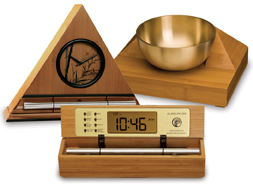 quality of thought, stillness of being Now & Zen Headquarter Store
1638 Peal Street
Boulder, CO 80302
(800) 779-6383
Posted in Goodness, mindfulness practice, Natural Awakening, Well-being
 Sleep your way to a better health with The Zen Alarm Clock A good night’s rest can help you lose weight, beat depression, and ward off heart disease.
People think sleep is a waste of time,” says James P. Krainson, M.D., director of the South Florida Sleep Diagnostic Center in Miami. “But they don’t realize that sleep will make them more productive.” It will also help you improve your memory, shed postpregnancy pounds, and stave off obesity, heart disease, and diabetes. Dozens of studies support the notion that sleep is just as important for maintaining good health as diet and exercise. For example, a study published in the journal Sleep found a relationship between short sleep and increased diabetes risk. Other studies found a lack of sleep can exacerbate pain, cause mood disturbances, and even increase the risk of gum disease.
Your wake-up call. If results from a 2007 Sleep in America poll are anything to go by, too many women are risking their health from lack of sleep. Conducted by the National Sleep Foundation (NFS), last year’s poll revealed that 60 percent of American women get a good night’s sleep only a few nights per week or less. Apparently, when women are pressed for time—which, let’s face it, is every day—sleep is usually the first thing to go.
Take back the night. With health benefits that important, you can’t ignore those eight hours of shuteye any longer. To help you get back in bed and waking up well rested, we looked at four sleep ailments—and discovered some surprisingly effortless solutions.
THE PROBLEM: No time
Recent research at the University of Pennsylvania, published in 2007 in Sleep, says our work-driven culture keeps us from getting the rest we need. Among the findings: The more time we spend working and com- muting, the less time we spend in bed. Even when we know that get- ting more sleep will make us feel better, it usually isn’t enough to keep us from burning the candle at both ends, says Michael Breus, Ph.D., sleep expert and author of Beauty Sleep: Look Younger, Lose Weight, and Feel Great Through Better Sleep (Plume, 2007). What’s required, Breus says, is a plan for making sleep a priority:
Set your ZenAlarm Clock for sleep. Set your alarm to go off an hour before you want to go to sleep. The alarm is your cue to start getting ready for bed.
Wind down for an hour. Take 20 minutes to shut down the house for the night and prepare for the next morning. Spend the next 20 minutes doing your usual evening ablutions like washing your face, brushing your teeth, and changing into your pj’s. For the final 20 minutes, relax and meditate in bed. That’s it. No work, reading, e-mails, phone calls, paying bills, or getting into a discussion with your partner about your health, finances, or relationship during your power-down hour, says Breus. “Avoid any activity that gets your mind revved up before you go to bed,” he advises.
Create a sleep sanctuary. “I’ve gone into bedrooms of people who say they can’t sleep, and they’ve got a computer in there, a TV, a huge pile of laundry on the floor,” says Breus. The question then becomes, according to Breus, not “Why can’t I sleep?” but “How could I sleep under these circumstances?” To transform your bedroom, Breus recommends moving the computer and the TV out of the room and clearing out the clutter. “You want to create an area that’s flowing and positive,” he writes in his book Beauty Sleep.
Adapted from Natural Health Magazine, July 2010 by Susan Hayes
 Sleep your way to better health and wake up gently with a Zen Clock
Posted in Bamboo Chime Clocks, Chime Alarm Clocks, Goodness, Natural Awakening, Now & Zen Alarm Clocks, Sleep Habits
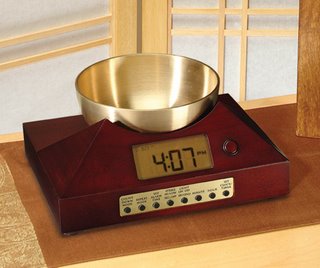 Zen Timepiece with brass bowl
Discover the healing power of sound with singing bowls, tuning forks, and other musical instruments.
Music can move us to tears, help us feel calm or comforted, or inspire us to action. The rhythmic sounds of nature (think of waves breaking on a beach) can bring us into balance. Now researchers are learning more about how music and sound directly affect the healing process.
EVIDENCE. A 2008 study at the University of Maryland School of Medicine revealed that listening to music you consider joyful for 30 minutes helps release endorphins to relieve pain and reduce stress, which can otherwise overload your immune system and lead to a host of health conditions. Another study completed last year at Seattle University in Washington showed that listening to Mozart for 12 minutes three times a week can lower systolic blood pressure by seven points.
YOUR BODY TUNES IN. Researchers say that when you listen to music and sounds, your heartbeat, breath, and brain waves begin to slow down or speed up in response to what you’re hearing. Your body syncs up with the sound, and the result can be an enhanced relaxation response—stress lifts, your heartbeat slows, muscles relax, and your body releases feel-good endorphins—or improved energy levels, depending on the rhythm.
GET STARTED. Try these ways to benefit from sound therapy:
EASE STRESS:
Use tuning forks and singing bowls
“Sonic tools” like tuning forks and singing bowls can soothe an overexcited nervous system, says Jonathan Goldman, author of The Seven Secrets of Sound Healing (Hay House, 2008). Singing bowls create a calming noise when you run a mallet around the rim, and tuning forks hum when tapped.
Try it: Use these tools as frequently as needed, says Goldman. For tuning forks, go to Healing Sounds or Biosonics. For crystal singing bowls, visit Crystal Tones. For Tibetan singing bowls, try Now & Zen, Inc., Headquarter Store, 1638 Pearl Street, Boulder, CO 80302.
RELIEVE INSOMNIA:
Listen to a healing CD
“Music is to the nervous system what nutrients are to the body,” says Joshua Leeds, author of The Power of Sound (Healing Arts Press, 2001). He designs audio CDs with music, special effects, and sounds from the natural world to enhance various activities, such as falling asleep.
Try it: See Sound Remedies or Steven Halpern Inner Peace Music.
SHARPEN YOUR MIND:
Learn an instrument
Studies show that daily practice of a musical instrument can keep the brain young and pliable. It can also help relieve tension as your body actually resonates with the soft energies of the instrument.
Try it: Find a local teacher and ask about beginner lessons. Practicing for five minutes can clear tension and a foggy mind. Use your Zen Timepiece in the morning to wake up to a singing bowl for a gentle and progressive awakening.
Our Zen Timepiece’s acoustic 6-inch brass bowl-gong clock is the world’s ultimate alarm clock, practice timer, and “mindfulness bell.”
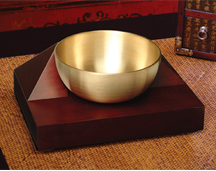 Natural Sound Alarm Clocks & Sound Therapy It fills your environment with beautifully complex tones whenever it strikes. In the morning, its exquisite sounds summon your consciousness into awakening with a series of subtle gongs that provide an elegant beginning to your day. Once you experience the Zen Timepiece’s progressive awakening, you’ll never want to wake up any other way. It also serves as the perfect meditation timer.
adapted from Natural Health Magazine July 2010, by Elizabeth Casey
 Singing Bowl Clocks by Now & Zen called The Zen Timepiece
Posted in Bamboo Chime Clocks, Chime Alarm Clocks, Goodness, Meditation Timers, Meditation Tools, mindfulness practice, Natural Awakening, Progressive Awakening, Well-being, Zen Timepiece by Now & Zen, Zen Timers
 sacred spaces Create a personal meditation space that inspires your practice and invokes your higher self.
By Sandra Anderson
If you’re a gardener, you know the value of choosing an ideal site and preparing quality soil for nurturing healthy plants. The same is true for tending to your inner growth: when you devote a nook in your home to your practice and sow it with your higher intentions, you create the right conditions for your spiritual life to thrive.
A dedicated space collects and focuses your energy, removes uncertainty about where to practice, and, through habit and association, helps the mind move inward more quickly and deeply. Much like an encounter with the refrigerator conjures thoughts of food, and a glance at the couch invites a comfortable sprawl, catching sight of your meditation seat in a sanctified space will evoke your deepest yearnings and inspire you to do your practice.
Choose a place that can become a sanctuary—a quiet, private space protected from outside distractions and out of public view. You may be fortunate enough to designate an entire room, but a corner in your bedroom will suffice.
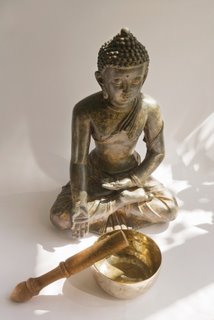 Carved Wooden Thai Buddha with Singing Bowl You’ll need a meditation seat—traditionally known as your asana—which may be a neatly folded blanket topped by a cushion for support, or even a chair or bench. Keep any additional props needed to support a comfortable sitting posture nearby, as well as your mala, shawl, or journal; but otherwise keep the space uncluttered and scrupulously clean.
A simple altar will serve as the heart of your space, calling you to your practice by providing inspiration and focus. An altar is an acknowledgement of the deeper essence of life and a bridge to the unseen—a link between our life in the world of elements and the subtle world. All altars, even public ones, serve to remind us of meaning and purpose in life, and connect us to inner strength and guidance. In religious or ritual settings, an altar is the locus for offerings made to ancestors or deities. In the context of yoga meditation, an altar inspires an offering of inner resources rather than outward ceremony or ritual, so simplicity is key.
Try a small low table or a small chest of drawers at eye level, with a tasteful and simple covering. The objects you place upon your altar give focus, substance, and energy to your highest intentions. Traditionally, a flame (from a candle or a ghee lamp), water, flowers, fruit, and incense are offered on an altar to represent the gifts of the world given to us through the five elements. Often, these are joined by objects from a pilgrimage—a stone, sanctified water, or a sacred representation (such as a picture of Our Lady of Guadalupe or a carving of Lord Ganesha). The objects themselves are not as important as whether the altar uplifts the mind and touches the heart.
By creating a sacred space that encourages you to cultivate and nurture a devoted practice, you are one step closer to tasting the fruits of yoga—unconditional well-being and pure awareness.
Our Zen Timepiece’s acoustic 6-inch brass bowl-gong clock & Timer is the world’s ultimate alarm clock, practice timer, and “mindfulness bell.” It awaken you with the beautiful tones of a singing-bowl, used by many sound therapist.
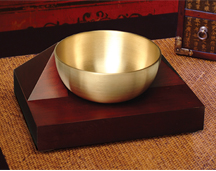 Singing Bowl Timer It fills your environment with beautifully complex tones whenever it strikes. In the morning, its exquisite sounds summon your consciousness into awakening with a series of subtle gongs that provide an elegant beginning to your day. Once you experience the Zen Timepiece’s progressive awakening, you’ll never want to wake up any other way. It also serves as the perfect meditation timer. Available in 5 wood styles, including bamboo.
Remember to set your Singing Bowl Timer for 20 minutes each day – for a lovely meditation in your new sweet sanctuary.
 Now & Zen's Showroom, a place to find meditation tools and clocks Now & Zen’s Singing Bowl Timer Store
1638 Pearl St.
Boulder, CO 80302
(800) 779-6383
Posted in Goodness
 Warm winter sun Winter solitude–
in a world of one color
the sound of wind.
by Matsu Basho
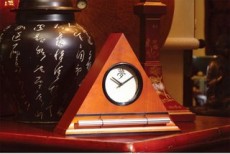 Chime Alarm Clock Now & Zen
1638 Pearl St.
Boulder, CO 80302
(800) 779-6383
Posted in Goodness, nature
« Previous Entries
Next Page »
|
|
|
|